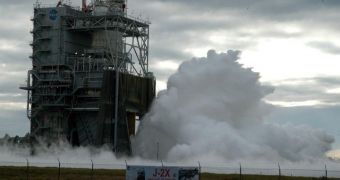Yesterday, November 9, the American space agency conducted a new burn test with its new J-2X rocket engines, at the Stennis Space Center (SSC), in Mississippi. The assessments revealed that yet another milestone in the development of the upper stage for the new Space Launch System has been reached.
The SLS is the new heavy-lift rocket that NASA is starting to develop for the United States. The delivery system can deliver more than 100 tons of cargo to low-Earth orbit (LEO), and is the second-largest rocket for the country since the Saturn V boosters that carried the Apollo capsules to the Moon.
However, the SLS project has already divided the country's policymakers, with some agreeing with the new design and direction NASA took for space exploration, while other strongly disagree. But for now, the rocket is being developed as fast as possible.
The space agency is looking to pair the rocket with the Orion Multi-Purpose Crew Vehicle (MPCV) space capsule, which is currently being developed by Lockheed Martin. The two could fly together to the Moon, Mars, a near-Earth asteroid or Earth's orbit.
In order for that to happen, the Space Launch System needs to be able to deliver both its upper stage and the Orion capsule to space. As such, the J-2X engine that will outfit its upper stage will have a very important role to play in the success or failure of future American space missions.
NASA is currently very confident in the motor's abilities, but that did not preclude it from conducting the new tests. On Wednesday, an SLS test motor was ignited for about 500 seconds. This simulated the time the engines would have to remain active during actual launches.
“The J-2X engine is critical to the development of the Space Launch System. Today's test means NASA is moving closer to developing the rocket it needs if humans are to explore beyond low-Earth orbit,” explains the NASA deputy associate administrator for exploration systems development, Dan Dumbacher.
“The J-2X engine team and the SLS program as a whole are extremely happy that we accomplished a good, safe and successful test today. This engine test firing gives us critical data to move forward in the engine's development,” Mike Kynard adds.
The official holds an appointment with the NASA Marshall Space Flight Center, in Huntsville, Alabama, where he is the Engines Element Manager for the SLS project.
“We look forward to adding to the legacy as we fulfill our responsibility to test engines that will power America's next launch vehicl,” SSC Director Patrick Scheuermann said immediately after launch.

 14 DAY TRIAL //
14 DAY TRIAL //